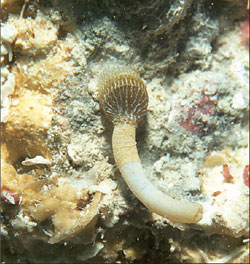Lesser Protostomes
 |
| A sipunculan. |
During the Cambrian Period, about 535 to 530 million years ago, a most fertile time occurred in evolutionary history. For over 3 billion years before this time, evolution had forged little more than prokaryotes and unicellular eukaryotes. Then, within the space of a few million years, all of the major phyla of macroscopic invertebrates, and probably all of the smaller phyla, became established. This was the Cambrian explosion, the greatest evolutionary “bang” the world has known. In fact, the fossil record suggests that more phyla existed in the Paleozoic Era than exist now, but some disappeared during major extinction events that punctuated the evolution of life on earth. The greatest of these disruptions was the Permian extinction about 230 million years ago. Thus evolution has led to many “experimental models.” Some of these models failed because they were unable to survive in changing conditions. Others gave rise to abundant and dominant species and individuals that inhabit the world today. Still others produced a small number of species, some of which persist, while others were formerly more abundant but are now in decline.
The great evolutionary flow that began with the appearance of a coelom and led to the three huge phyla of molluscs, annelids, and arthropods produced other lines as well. Those that have survived are small and lack great economic and ecological importance; they are sometimes grouped together as “lesser protostomes.” They probably diverged at different times from different ancestors, but in all likelihood each is phylogenetically close to annelids or arthropods.
Position in the Animal Kingdom
The phyla discussed in this section are all coelomate protostomes, although some also have some deuterostome characteristics in their embryological development. Their relationship to each other and to the major protostome phyla is often puzzling, but they all probably are phylogenetically close to annelids and arthropods.
Lesser Protostomes
This topic includes a brief discussion of six phyla whose positions in the phylogenetic lines of the animal kingdom are somewhat problematical, as are their relationships to each other. The coelomate, protostome ancestors that eventually produced the three major phyla—Mollusca, Annelida, and Arthropoda—also produced a number of other lines. Some are now extinct, whereas others, although small in number of species and marked by very little evolutionary divergence within each phylum, have survived.
Three phyla, Sipuncula, Echiura, and Pogonophora, are benthic (bottomdwelling) marine worms that may be phylogenetically close to annelids. The first two have a variety of proboscis devices used in burrowing and food gathering. Pogonophores live in tubes, mostly in deep-sea mud, have long anterior tentacles, and lack a digestive tract. Pentastomida, Onychophora, and Tardigrada have sometimes been grouped together and called pararthropods because they have unjointed limbs with claws (at some stage) and a cuticle that undergoes molting, suggesting that they share an ancestor with arthropods. Pentastomida are entirely parasitic; Onychophora are terrestrial but are limited to damp areas; Tardigrada are found in marine, freshwater, and terrestrial habitats.




